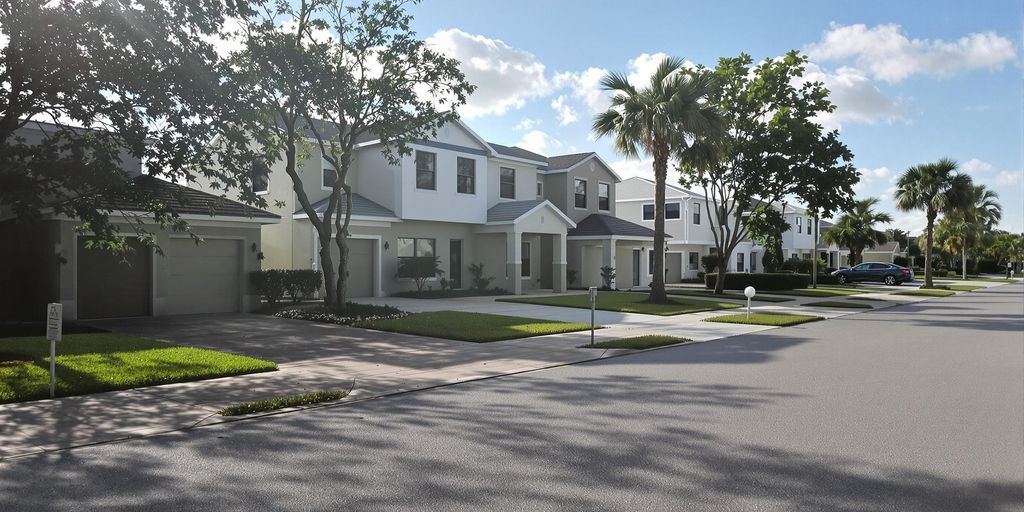Florida’s once-booming housing market is experiencing a significant cool-down, marked by rising inventory, declining prices in many areas, and a shift from a seller’s to a buyer’s market. This change is attributed to factors like increased supply, reduced demand, high mortgage rates, and soaring insurance costs, leading to a more balanced, and in some cases, buyer-favored environment.
Florida’s Housing Market Takes a Turn
Florida’s real estate landscape is undergoing a notable transformation. After years of rapid appreciation and intense competition, the market is now seeing a significant increase in available homes and a moderation, or even decline, in prices across many regions. This shift is particularly evident in the Sun Belt, with Florida dominating the list of areas where sellers are slashing prices to attract buyers.
- Key Takeaways:
- Florida cities account for more than half of U.S. metros with the most price cuts.
- Inventory has quadrupled since late 2022.
- The market is moving from a seller’s to a more balanced or buyer-favored state.
Inventory Surges and Prices Ease
Active listings of existing homes for sale in Florida soared by 32% year-over-year in May, reaching 181,822 listings. This represents a 26% increase from May 2019 and a 34% increase from May 2018. This surge in unsold inventory is not due to a sudden influx of new listings, but rather a significant drop in sales, indicating a withered demand. The statewide median sales price for single-family homes in February remained flat at $415,000 compared to the previous year, while condo-townhouse units saw a 3.1% decrease to $315,000.
Regional Variations and High-Risk Markets
While the statewide trend points to a cooling market, some areas are experiencing more pronounced shifts than others. Several Florida metros have seen their inventory levels compared to 2019 or 2018 increase by 30%, 40%, 50%, or even 80% (Lakeland-Winter Haven). Miami, however, has seen a comparatively smaller increase of 5% in inventory compared to May 2019.
According to Cotality (formerly CoreLogic) data from April 2025, five Florida housing markets have been flagged with a "very high risk" of experiencing a major price decline. These include:
| Risk Rank | Market Name |
|---|---|
| 1. | Cape Coral, FL |
| 2. | Lakeland, FL |
| 3. | North Port, FL |
| 4. | St. Petersburg, FL |
| 5. | West Palm Beach, FL |
These markets, which experienced explosive growth during the boom, are now facing significant headwinds due to factors such as affordability reaching a breaking point, increased inventory, cooling migration, and investor pullback. For instance, Cape Coral saw a year-over-year price decline of 6.5% in April 2025.
Factors Contributing to the Downturn
The current market correction in Florida is a confluence of several factors:
- Affordability Crisis: Despite recent dips, prices remain significantly higher than pre-pandemic levels. Coupled with elevated mortgage rates, many potential buyers are simply priced out.
- Soaring Insurance Costs: Florida’s average home insurance premiums are approximately $11,000 annually, nearly four times the national average, adding a substantial burden to homeownership.
- Increased Inventory: As demand wanes, homes are sitting on the market longer, leading to a surplus of available properties and reducing sellers’ leverage.
- Reduced Demand: The frantic pace of migration to Florida has slowed, and the high cost of living is prompting some to reconsider.
- Investor Pullback: Higher interest rates and the prospect of falling prices have made real estate investments less attractive, reducing a key source of demand.
Implications for Buyers and Sellers
For buyers, the cooling market presents potential opportunities, but caution is advised. Due diligence regarding HOA fees, property taxes, and insurance costs is crucial. For sellers, particularly in high-risk areas, pricing homes correctly based on current market conditions is paramount. The days of multiple cash offers are largely over, and sellers should be prepared for longer market times and potential negotiations.
This period of adjustment is seen by some as a necessary and healthy correction for a market that experienced unsustainable growth. The extent of future price adjustments will depend on ongoing supply and demand dynamics, interest rate fluctuations, and the stability of local job markets.
Sources
- Housing market hitting the brakes? New analysis finds Florida dominates areas slashing home prices, Florida Politics.
- Attorney shares must-know advice for homebuyers as Florida’s real estate crash stuns experts, San Diego Reader.
- Fla.’s Housing: Inventory Up, Median Prices Ease, Florida Realtors.
- Inventory of Homes for Sale in the Biggest Florida Metros Piles Up to Highest in Years as Demand Has Withered
| Wolf Street, Wolf Street. - 5 Big Florida Housing Markets Flagged for a Major Price Decline Risk, Norada Real Estate Investments.


